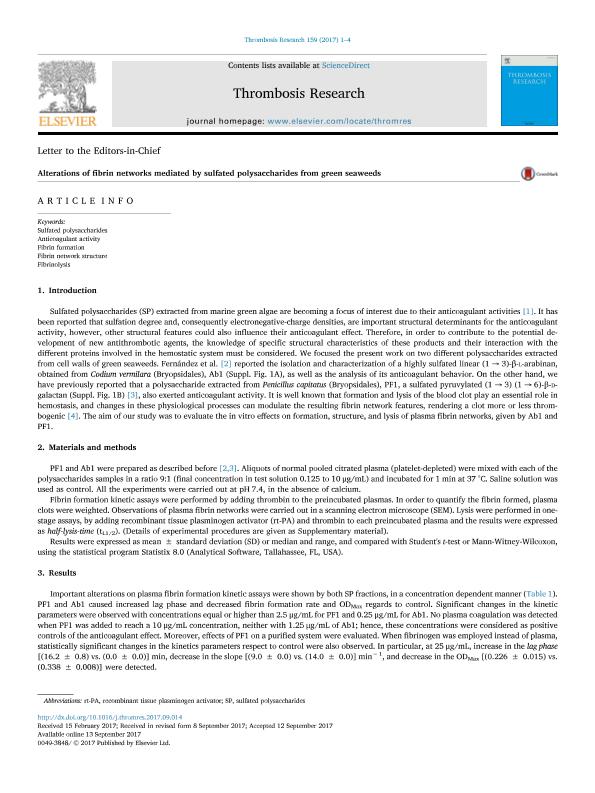Artículo
Alterations of fibrin networks mediated by sulfated polysaccharides from green seaweeds
Arata, Paula Ximena; Genoud, Valeria; Lauricella, Ana Maria; Ciancia, Marina ; Quintana, Irene Luisa
; Quintana, Irene Luisa
 ; Quintana, Irene Luisa
; Quintana, Irene Luisa
Fecha de publicación:
11/2017
Editorial:
Pergamon-Elsevier Science Ltd
Revista:
Thrombosis Research
ISSN:
0049-3848
Idioma:
Inglés
Tipo de recurso:
Artículo publicado
Clasificación temática:
Resumen
Kinetics of fibrin formation was affected by SP from Codium vermilara (Bryopsidales), Ab1 and Penicillus capitatus (Bryopsidales), PF1, showing delayed polymerization curves, in a concentration dependent manner. Increased times required for initial protofibrils formation (lag phase) and decreased maximum velocities achieved (slope) observed in our assays are related to an anticoagulant behavior. On the other hand, in the presence of increasing concentrations of each of the SP, decreases in the amount of fibrin generated were detected, denoting a reduced quantity of clotted fibrinogen, consequence of the anticoagulant action of the SP. This behavior of PF1 and Ab1 would be due to the thrombin inhibition mediated by the SP, as was mentioned above.When equal concentrations of each polysaccharide were employed in fibrin formation assays, very different results were observed. In particular, at a concentration of 5 µg/mL an important anticoagulant activity was demonstrated for PF1, but this effect was so important in the case of Ab1, that no coagulation was detected.In addition, in fibrin formation curves lower final optical densities respect to control were registered in the presence of the SP. It is well known that the final turbidity measurement is related to the weight-averaged mass per unit length (mass/length ratio) of fibrin fibers composing the clot, allowing to infer the structure of the network. The mass/length ratio proved to be lower, and consequently, gave a lower optical density value. Moreover, the delayed kinetics observed in our fibrin polymerization assays is associated to prolonged lateral aggregation times, yielding clots with few branch points and thicker fibers.In the presence of PF1 and Ab1 accelerated fibrinolysis rates were observed, mostly attributed to the reduced amount of fibrin formed. This fact is the result of diminished thrombin activity, mediated, direct or indirectly, by these SP, which induces clotting of a lesser amount of fibrinogen and consequently generates less fibrin. On the other hand, SEM showed important differences between networks. The final fibrin structure obtained in the presence of PF1 (5 μg/mL) and also in the presence of Ab1, but in this case, at a lower concentration (0.25 μg/mL), was less compact than control, composed by thicker and longer fibers. These changes in fibrin architecture could also contribute to the improved fibrinolysis observed when plasminogen was activated by rt-PA. In summary, the structural and functional features of the clots generated in the presence of PF1 and Ab1 are consequences of the anticoagulant action of these SP which, direct or indirectly, can reduce the thrombin activity. In particular, lower concentrations (expressed as mass/vol) of Ab1 than of PF1 were needed to produce similar anticoagulant effects. Our results show different characteristics of the fibrin, resulting from the action of SP, contributing to the understanding of their anticoagulant activity, and to the development of new compounds with antithrombotic therapeutic properties.
Archivos asociados
Licencia
Identificadores
Colecciones
Articulos(CIHIDECAR)
Articulos de CENTRO DE INVESTIGACIONES EN HIDRATOS DE CARBONO
Articulos de CENTRO DE INVESTIGACIONES EN HIDRATOS DE CARBONO
Citación
Arata, Paula Ximena; Genoud, Valeria; Lauricella, Ana Maria; Ciancia, Marina; Quintana, Irene Luisa; Alterations of fibrin networks mediated by sulfated polysaccharides from green seaweeds; Pergamon-Elsevier Science Ltd; Thrombosis Research; 159; 11-2017; 1-4
Compartir
Altmétricas



